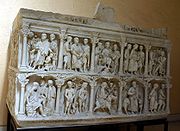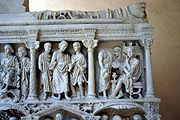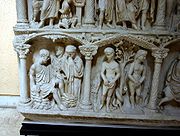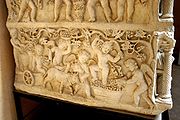
Sarcophagus of Junius Bassus
Encyclopedia


Sarcophagus
A sarcophagus is a funeral receptacle for a corpse, most commonly carved or cut from stone. The word "sarcophagus" comes from the Greek σαρξ sarx meaning "flesh", and φαγειν phagein meaning "to eat", hence sarkophagus means "flesh-eating"; from the phrase lithos sarkophagos...
used for the burial of Junius Bassus
Junius Bassus
Iunius Bassus signo Theotecnius was an ancient Roman politician. The son of the praetorian prefect Junius Annius Bassus, he was vir clarissimus and vicarius of Rome as well as praefectus urbi from 25 March to 25 August 359. The important Sarcophagus of Junius Bassus shows him to have been a...
, who died in 359
359
Year 359 was a common year starting on Friday of the Julian calendar. At the time, it was known as the Year of the Consulship of Eusebius and Hypatius...
. It has been described as "probably the single most famous piece of early Christian relief sculpture." The sarcophagus was originally placed in or under Old St. Peter's Basilica, was rediscovered in 1597, and is now below the modern basilica in the Museo Storico del Tesoro della Basilica di San Pietro (Museum of Saint Peter's Basilica) in the Vatican
Vatican City
Vatican City , or Vatican City State, in Italian officially Stato della Città del Vaticano , which translates literally as State of the City of the Vatican, is a landlocked sovereign city-state whose territory consists of a walled enclave within the city of Rome, Italy. It has an area of...
. The base is approximately 4 x 8 x 4 feet.
Together with the Dogmatic sarcophagus
Dogmatic sarcophagus
The Dogmatic Sarcophagus, also known as the "Trinity Sarcophagus" is an early Christian sarcophagus of about 320–350, now in the Vatican Museums...
in the same museum, this sarcophagus is one of the oldest surviving high-status sarcophagi with elaborate carvings of Christian themes, and a complicated iconographic
Iconography
Iconography is the branch of art history which studies the identification, description, and the interpretation of the content of images. The word iconography literally means "image writing", and comes from the Greek "image" and "to write". A secondary meaning is the painting of icons in the...
programme embracing the Old
Old Testament
The Old Testament, of which Christians hold different views, is a Christian term for the religious writings of ancient Israel held sacred and inspired by Christians which overlaps with the 24-book canon of the Masoretic Text of Judaism...
and New Testament
New Testament
The New Testament is the second major division of the Christian biblical canon, the first such division being the much longer Old Testament....
s.
Junius Bassus
Junius Bassus was an important figure, a senator who was in charge of the government of the capital as praefectus urbiPraefectus urbi
The praefectus urbanus or praefectus urbi, in English the urban prefect, was prefect of the city of Rome, and later also of Constantinople. The office originated under the Roman kings, continued during the Republic and Empire, and held high importance in late Antiquity...
when he died at the age of 42 in 359. His father had been Praetorian prefect
Praetorian prefect
Praetorian prefect was the title of a high office in the Roman Empire. Originating as the commander of the Praetorian Guard, the office gradually acquired extensive legal and administrative functions, with its holders becoming the Emperor's chief aides...
, running the administration of a large part of the Western Empire. Bassus served under Constantius II
Constantius II
Constantius II , was Roman Emperor from 337 to 361. The second son of Constantine I and Fausta, he ascended to the throne with his brothers Constantine II and Constans upon their father's death....
, son of Constantine I
Constantine I
Constantine the Great , also known as Constantine I or Saint Constantine, was Roman Emperor from 306 to 337. Well known for being the first Roman emperor to convert to Christianity, Constantine and co-Emperor Licinius issued the Edict of Milan in 313, which proclaimed religious tolerance of all...
. Bassus, as the inscription on the sarcophagus tells us, converted to Christianity shortly before his death - perhaps on his deathbed. Many still believed, like Tertullian
Tertullian
Quintus Septimius Florens Tertullianus, anglicised as Tertullian , was a prolific early Christian author from Carthage in the Roman province of Africa. He is the first Christian author to produce an extensive corpus of Latin Christian literature. He also was a notable early Christian apologist and...
, that it was not possible to be an emperor and a Christian, which also went for the highest officials like Bassus.
Style
The style of the work has been greatly discussed by art historians, especially as its date is certain, which is unusual at this period. All are agreed that the workmanship is of the highest quality available at the time, as one might expect for the tomb of such a prominent figure.
Arch of Constantine
The Arch of Constantine is a triumphal arch in Rome, situated between the Colosseum and the Palatine Hill. It was erected to commemorate Constantine I's victory over Maxentius at the Battle of Milvian Bridge on October 28, 312...
of several decades earlier: "The sculpture ignores practically all the rules obeyed by official reliefs. Some figures are portrayed frontally, but certainly not all, and they are not shown in a thoroughly Late Antique manner; the scenes are three-dimensional and have depth and background .... drapery hangs on recognizable human forms rather than being arranged in predetermined folds; heads are varied, portraying recognisably different people." The sarcophagus has been seen as reflecting a blending of late Hellenistic style with the contemporary Roman or Italian one, seen in the "robust" proportions of the figures, and their slightly over-large heads.
The setting in the niches casts the figures against a background of shadow, giving "an emphatic chiaroscuro
Chiaroscuro
Chiaroscuro in art is "an Italian term which literally means 'light-dark'. In paintings the description refers to clear tonal contrasts which are often used to suggest the volume and modelling of the subjects depicted"....
effect" - an effect much more noticeable in the original than the cast shown here, which has a more uniform and lighter colour. The cast also lacks the effects created by light on polished or patinated highlights such as the heads of the figures, against the darker recessed surfaces and backgrounds.
Iconography

Asia Minor
Asia Minor is a geographical location at the westernmost protrusion of Asia, also called Anatolia, and corresponds to the western two thirds of the Asian part of Turkey...
at about this time. No portrait of the deceased is shown, though he is praised in lavish terms in an inscription; instead, the ten niches are filled with scenes from both the New and Old Testament
Old Testament
The Old Testament, of which Christians hold different views, is a Christian term for the religious writings of ancient Israel held sacred and inspired by Christians which overlaps with the 24-book canon of the Masoretic Text of Judaism...
s, plus one, the Traditio Legis, that has no Scriptural basis.
The scenes on the front are:
- Top row: Sacrifice of Isaac, Judgement or Arrest of PeterSaint PeterSaint Peter or Simon Peter was an early Christian leader, who is featured prominently in the New Testament Gospels and the Acts of the Apostles. The son of John or of Jonah and from the village of Bethsaida in the province of Galilee, his brother Andrew was also an apostle...
, Enthroned Christ with Peter and Paul (Traditio Legis), and a double scene of the Trial of Jesus before Pontius PilatePontius PilatePontius Pilatus , known in the English-speaking world as Pontius Pilate , was the fifth Prefect of the Roman province of Judaea, from AD 26–36. He is best known as the judge at Jesus' trial and the man who authorized the crucifixion of Jesus...
, who in the last niche is about to wash his hands. - Bottom row: Job on the dunghill, Adam and EveAdam and EveAdam and Eve were, according to the Genesis creation narratives, the first human couple to inhabit Earth, created by YHWH, the God of the ancient Hebrews...
, Christ's entry into JerusalemPalm SundayPalm Sunday is a Christian moveable feast that falls on the Sunday before Easter. The feast commemorates Jesus' triumphal entry into Jerusalem, an event mentioned in all four Canonical Gospels. ....
, DanielDanielDaniel is the protagonist in the Book of Daniel of the Hebrew Bible. In the narrative, when Daniel was a young man, he was taken into Babylonian captivity where he was educated in Chaldean thought. However, he never converted to Neo-Babylonian ways...
in the lion's den (heads restored), Arrest or leading to execution of Paul.

Spandrel
A spandrel, less often spandril or splaundrel, is the space between two arches or between an arch and a rectangular enclosure....
s above the lower row show scenes with all participants depicted as lambs: on either side of Christ entering Jerusalem are the Miracle of the loaves and fishes and the Baptism of Jesus
Baptism of Jesus
The baptism of Jesus marks the beginning of Jesus Christ's public ministry. This event is recorded in the Canonical Gospels of Matthew, Mark and Luke. In John 1:29-33 rather than a direct narrative, the Baptist bears witness to the episode...
. The other scenes may be the Three youths in the fiery furnace
Fiery furnace
Fiery furnace may refer to:* The fiery furnace in which Shadrach, Meshach, and Abednego were thrown into in Daniel 3* Fiery Furnace , a region of Utah's Arches National Park* The Fiery Furnaces, a rock band...
, the Raising of Lazarus
Raising of Lazarus
The Raising of Lazarus or the Resurrection of Lazarus is one of the miracles of Jesus in the Gospels in which Jesus brings Lazarus of Bethany back to life four days after his burial....
, Moses
Moses
Moses was, according to the Hebrew Bible and Qur'an, a religious leader, lawgiver and prophet, to whom the authorship of the Torah is traditionally attributed...
receiving the tablets and Moses striking the rock.
The sides have more traditional Roman scenes of the Four Seasons
Season
A season is a division of the year, marked by changes in weather, ecology, and hours of daylight.Seasons result from the yearly revolution of the Earth around the Sun and the tilt of the Earth's axis relative to the plane of revolution...
represented by putti performing seasonal tasks such as harvesting grapes. On a damaged plaque surmounting the lid is a poem praising Bassus in largely secular terms, and the inscription running along the top of the body of the sarcophagus identifies him, and describes him as a "neophyte", or recent convert. Further small reliefs on the lid, and heads at the corners, are badly damaged, they showed scenes of feasts and a burial procession typical of pagan sarcophagi; it is possible the lid was not created to match the base.
Scenes with Christ
The emphasis on scenes of judgement may have been influenced by the career of Bassus as a magistrate, but all the scenes shown can be paralleled in other Christian works of the period.
Abraham
Abraham , whose birth name was Abram, is the eponym of the Abrahamic religions, among which are Judaism, Christianity and Islam...
in the Sacrifice of Isaac is depicted similarly, and without wings. Christ appears in the centre of both rows; in the top row as a law-giver or teacher between his chief followers, Peter and Paul (the Traditio Legis), and on the bottom entering Jerusalem. Both scenes borrow from pagan Roman iconography: in the top one Jesus is sitting with his feet on a billowing cloak representing the sky, carried by Caelus
Caelus
Caelus or Coelus was a primal god of the sky in Roman myth and theology, iconography, and literature...
, the classical personification of the heavens. Christ hands Peter a scroll, probably representing the Gospel
Gospel
A gospel is an account, often written, that describes the life of Jesus of Nazareth. In a more general sense the term "gospel" may refer to the good news message of the New Testament. It is primarily used in reference to the four canonical gospels of Matthew, Mark, Luke, and John...
s, as emperors were often shown doing to their heirs, ministers or generals.
Before Pilate Christ also carries a scroll, like a philosopher. Pilate, perhaps worried by Jesus's reputation for miracles, is making the gesture Italians still use to ward off the evil eye
Evil eye
The evil eye is a look that is believed by many cultures to be able to cause injury or bad luck for the person at whom it is directed for reasons of envy or dislike...
. Pilate has a mild and passive appearance, contrasting strongly with the powerful and determined expression of the figure in low relief profile behind him on the wall, the only figure in these scenes depicted in this style and technique. If he is not just one of Pilate's subordinate officers, he may be intended as a portrait or statue of the emperor; Roman official business was usually conducted before such an image, upon which (under the deified pagan emperors) any oaths required were made.
The lower scene loosely follows the entry ("adventus") of an emperor to a city, a scene often depicted in Imperial art; Christ is "identified as imperator by the imperial eagle of victory" in the conch
Conch
A conch is a common name which is applied to a number of different species of medium-sized to large sea snails or their shells, generally those which are large and have a high spire and a siphonal canal....
moulding above the scene. There was already a tradition, borrowed from pagan iconography
Iconography
Iconography is the branch of art history which studies the identification, description, and the interpretation of the content of images. The word iconography literally means "image writing", and comes from the Greek "image" and "to write". A secondary meaning is the painting of icons in the...
, of depicting Christ the Victor; in this work that theme is linked to the Passion of Jesus, of which the entry to Jerusalem is the start, a development that was to play a great part in shaping the Christian art of the future.
The inclusion of the pagan figure of Caelus may seem strange, but he was not an important figure in Ancient Roman religion, so was evidently considered as a harmless pictorial convention by the Christian designer of the composition, as well as one of the elements showing continuity with Roman tradition. From the following century personifications of the River Jordan often appear in depictions of the Baptism of Jesus
Baptism of Jesus
The baptism of Jesus marks the beginning of Jesus Christ's public ministry. This event is recorded in the Canonical Gospels of Matthew, Mark and Luke. In John 1:29-33 rather than a direct narrative, the Baptist bears witness to the episode...
, and the manuscript Chronography of 354
Chronography of 354
The Chronography of 354, also known as the Calendar of 354, was a 4th century illuminated manuscript, which was produced in 354 AD for a wealthy Roman Christian named Valentinus. It is the earliest dated codex to have full page illustrations. None of the original has survived...
, just a few years older than the sarcophagus and made for another elite Christian, is full of personifications of cities, months and other concepts. The putti in the Chronography also relate closely to those on the sides of the sarcophagus.
Other scenes

New Testament
The New Testament is the second major division of the Christian biblical canon, the first such division being the much longer Old Testament....
, in an early form of typology
Typology (theology)
Typology in Christian theology and Biblical exegesis is a doctrine or theory concerning the relationship between the Old and New Testaments...
. Adam and Eve are shown covering their nakedness after the Fall of Man, which created the original sin
Original sin
Original sin is, according to a Christian theological doctrine, humanity's state of sin resulting from the Fall of Man. This condition has been characterized in many ways, ranging from something as insignificant as a slight deficiency, or a tendency toward sin yet without collective guilt, referred...
and hence the need for Christ to be sacrificed for our sins. Adam and Eve themselves made no sacrifices, but behind Eve is a lamb, and beside Adam a sheaf of wheat
Wheat
Wheat is a cereal grain, originally from the Levant region of the Near East, but now cultivated worldwide. In 2007 world production of wheat was 607 million tons, making it the third most-produced cereal after maize and rice...
, referring to the sacrifices of their two sons, Cain and Abel. Just to the right of the middle is Daniel in the lion's den, saved by his faith, and on the left is Abraham about to sacrifice Isaac. Job is seen at the point when he has lost everything, but retains his faith; his wife and a "comforter" look on anxiously. Christians saw these as foreshadowings of the sacrifice of God's only son, Jesus, though the Crucifixion
Crucifixion
Crucifixion is an ancient method of painful execution in which the condemned person is tied or nailed to a large wooden cross and left to hang until dead...
itself, a rare subject up until the 5th century, is not depicted.
The scenes prior to the martyrdoms of Peter and Paul, both common in Early Christian art, show the same avoidance of the climactic moments which were usually chosen in later Christian art. But they demonstrate to the viewer how the heavenly crown could be achieved by ordinary Christians, although the Imperial persecutions were now over. Both scenes also took place in Rome, and this local interest is part of the balance of Christian and traditional Roman gestures that the sarcophagus shows. The reeds behind Paul probably represent the boggy area of the city
San Paolo alle Tre Fontane
San Paolo alle Tre Fontane , in English, St Paul at the Three Fountains is a church dedicated to St Paul the Apostle, at the presumed site of his martyrdom in Rome...
where Paul's execution was traditionally believed to have happened. Peter's execution was believed to have happened close to his grave, which was within a few feet of the location of the sarcophagus; both executions were believed to have occurred on the same day
Feast of Saints Peter and Paul
The Feast of Saints Peter and Paul, or the Solemnity of Saints Peter and Paul, is a liturgical feast in honour of the martyrdom in Rome of the apostles Saint Peter and Saint Paul, which is observed on 29 June...
.
Further reading
- Elizabeth Struthers Malbon. The Iconography of the Sarcophagus of Junius Bassus. Princeton, NJ: Princeton University Press, 1990

